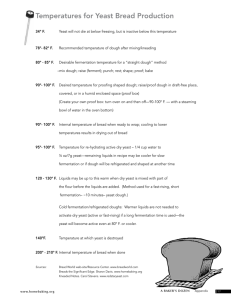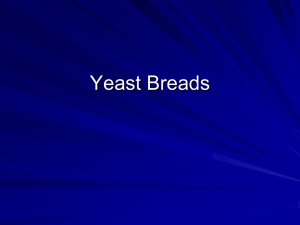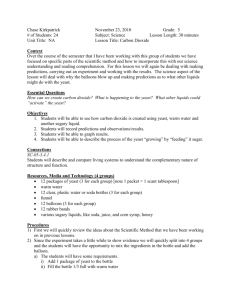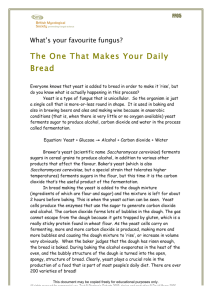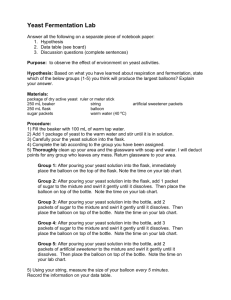Is Yeast Alive
advertisement
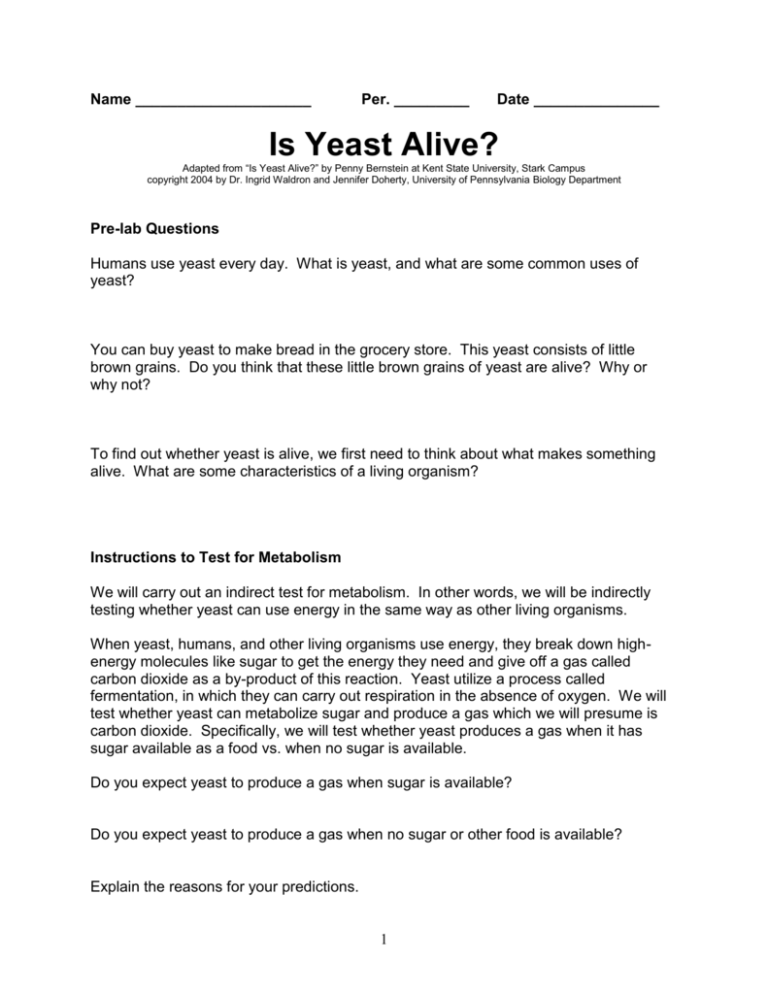
Name _____________________ Per. _________ Date _______________ Is Yeast Alive? Adapted from “Is Yeast Alive?” by Penny Bernstein at Kent State University, Stark Campus copyright 2004 by Dr. Ingrid Waldron and Jennifer Doherty, University of Pennsylvania Biology Department Pre-lab Questions Humans use yeast every day. What is yeast, and what are some common uses of yeast? You can buy yeast to make bread in the grocery store. This yeast consists of little brown grains. Do you think that these little brown grains of yeast are alive? Why or why not? To find out whether yeast is alive, we first need to think about what makes something alive. What are some characteristics of a living organism? Instructions to Test for Metabolism We will carry out an indirect test for metabolism. In other words, we will be indirectly testing whether yeast can use energy in the same way as other living organisms. When yeast, humans, and other living organisms use energy, they break down highenergy molecules like sugar to get the energy they need and give off a gas called carbon dioxide as a by-product of this reaction. Yeast utilize a process called fermentation, in which they can carry out respiration in the absence of oxygen. We will test whether yeast can metabolize sugar and produce a gas which we will presume is carbon dioxide. Specifically, we will test whether yeast produces a gas when it has sugar available as a food vs. when no sugar is available. Do you expect yeast to produce a gas when sugar is available? Do you expect yeast to produce a gas when no sugar or other food is available? Explain the reasons for your predictions. 1 Procedure: Day 1 1. Obtain 3 balloons. Inflate and deflate each of the balloons. Label one “A”, one “B”, one “C”, and one “D” with a sharpie. Write your group number (lab station #) on each balloon with a sharpie. 2. Obtain four 125-ml Erlenmeyer flasks labeled A, B, C, and D. 3. Add to each of the three flasks 2.0g of yeast, accurately weighed. 4. No sugar is added to Flask A Add one packet of sugar to Flask B. Add two packets of sugar to Flask C. Add one packet of Sweet and Low to Flask D 5. Add 100ml of 37° H2O to each flask. Swirl the contents gently to mix. 6. Using string and a ruler, measure the circumference of each of the balloons (use mm) and record in Data Table 1. 7. Continue measuring the circumference of each balloon every 5 minutes. Record in Data Table 1. 8. During your wait times complete the Pre-lab questions and clean up your laboratory station, except for the balloons you are using. 9. At the end of class, place your balloons on the tray designated for your class period. Day 2 10. 11. Obtain your balloons. Measure the circumference after 24 hours. Pop balloons and spill contents into a beaker. Waft the scent of the solution and record your observation into Data Table 2. Record data obtained from lab on the graph provided. 2 Data Table 1 Time (minutes) Balloon Circumference (mm) 0 5 10 15 20 A B C D Data Table 2 Balloon Qualitative Observation A B C D Variable on x-axis___________________________________ Variable on y-axis____________________________________ 3 25 24 hours Analysis Questions: 1. Discuss the results you obtained with your group. How do you interpret your results? 2. Why is it better to have two test tubes with yeast, sugar, and water and two test tubes with just yeast and water, instead of only one test tube with each type of mixture? 3. Why does the water used in the experiment need to be warm? 4. Why is fermentation important for yeast? 5. Fermentation is a type of anaerobic respiration. Explain the difference between anaerobic and aerobic respiration in terms of energy production. 6. When you make bread, if you just mix flour, sugar and water, the dough does not rise, and the bread will be flat and hard. If you include yeast in the bread dough, then the dough rises and the bread is bigger and fluffier. Can you explain how the yeast helps the bread dough to rise? Conclusions Based on our findings, do you think the little brown grains of yeast are alive? Explain why or why not. (Answer must be at least one paragraph) 4

